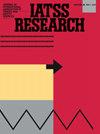Understanding psychological factors behind motorcyclists crossing behavior on undivided roads in mixed traffic conditions: A case study of Hau Giang, Vietnam
IF 3.3
Q3 TRANSPORTATION
引用次数: 0
Abstract
Motorcycle crashes are a common occurrence in developing countries with mixed traffic. A contributing factor to these crashes is the crossing maneuvers of motorcyclists on undivided roadways. This study applies the Theory of Planned Behavior to understand the intentions and behaviors of these motorcyclists when making such maneuvers. It utilizes data from two surveys conducted in Hau Giang, Vietnam in 2022. The first investigation surveyed 351 participants to elicit the motorcyclists' behavioral beliefs and control beliefs when making crossing maneuvers that complied with traffic rules (complying maneuvers, CM), and the second investigation interviewed 260 respondents to elicit motorcyclists' beliefs when making crossing maneuvers that violated traffic rules (illegal maneuvers, IM). By applying the Structural Equation Modeling approach, the results reveal that the intention of motorcyclists to perform crossing maneuvers (CMs) is influenced by facilitating circumstances, subjective norms, and descriptive norms. In contrast, the intention to perform improper maneuvers (IMs) is driven by advantage beliefs, descriptive norms, facilitating circumstances, subjective norms, and driving situation awareness. Additionally, risk perception directly affects motorcyclists' performance of CMs, while near-miss incidents related to IMs are directly influenced by facilitating circumstances and perceived risk. These findings suggest that reducing improper maneuvers and promoting safer road-crossing performance can be achieved through targeted safety intervention strategies. Such strategies could include addressing the consequences of advantage beliefs regarding IMs and enhancing riders' situation awareness and risk perception through driver education and training programs.
了解混合交通条件下摩托车手在未分割道路上穿越行为背后的心理因素:以越南Hau Giang为例
摩托车撞车事故在混合交通的发展中国家很常见。造成这些事故的一个因素是摩托车手在未分割的道路上的穿越动作。本研究运用计划行为理论来理解这些摩托车手在进行此类机动时的意图和行为。它利用了2022年在越南豪江进行的两次调查的数据。第一次调查通过对351名被试进行问卷调查,引出摩托车手在符合交通规则的情况下的行为信念和控制信念;第二次调查通过对260名被试进行问卷调查,引出摩托车手在违反交通规则的情况下的行为信念和控制信念。运用结构方程建模方法,研究结果表明:机动车驾驶员的穿越意愿受便利环境、主观规范和描述性规范的影响。相反,执行不当操作的意图是由优势信念、描述性规范、促进环境、主观规范和驱动情景意识驱动的。此外,风险感知直接影响摩托车手的医疗管理绩效,而与医疗管理相关的未遂事件直接受到便利环境和感知风险的影响。这些研究结果表明,通过有针对性的安全干预策略,可以减少不适当的操作,促进更安全的过马路行为。这些策略可以包括解决关于即时交通的优势信念的后果,并通过驾驶员教育和培训计划提高乘客的情况意识和风险感知。
本文章由计算机程序翻译,如有差异,请以英文原文为准。
求助全文
约1分钟内获得全文
求助全文
来源期刊

IATSS Research
TRANSPORTATION-
CiteScore
6.40
自引率
6.20%
发文量
44
审稿时长
42 weeks
期刊介绍:
First published in 1977 as an international journal sponsored by the International Association of Traffic and Safety Sciences, IATSS Research has contributed to the dissemination of interdisciplinary wisdom on ideal mobility, particularly in Asia. IATSS Research is an international refereed journal providing a platform for the exchange of scientific findings on transportation and safety across a wide range of academic fields, with particular emphasis on the links between scientific findings and practice in society and cultural contexts. IATSS Research welcomes submission of original research articles and reviews that satisfy the following conditions: 1.Relevant to transportation and safety, and the multiple impacts of transportation systems on security, human health, and the environment. 2.Contains important policy and practical implications based on scientific evidence in the applicable academic field. In addition to welcoming general submissions, IATSS Research occasionally plans and publishes special feature sections and special issues composed of invited articles addressing specific topics.
 求助内容:
求助内容: 应助结果提醒方式:
应助结果提醒方式:


